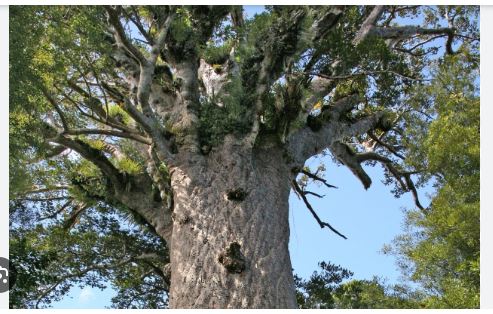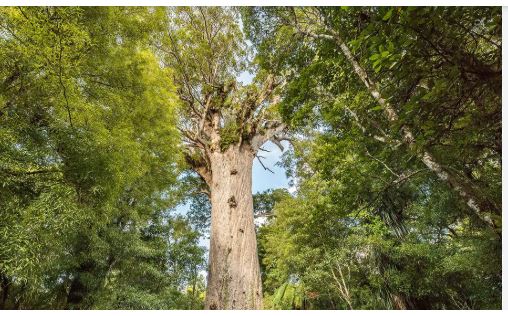
Botanical Classification
The Kauri, scientifically known as Agathis australis, belongs to the Araucariaceae family, which includes other ancient conifers like the Norfolk Island Pine and Wollemi Pine. It is part of the genus Agathis, comprising about 21 species of evergreen trees primarily found in the Southern Hemisphere. Commonly called the New Zealand Kauri or simply Kauri, Agathis australis is a coniferous tree renowned for its massive size and longevity. Its classification within the order Pinales aligns it with other conifers, reflecting its evolutionary lineage dating back to the Mesozoic era. The species name “australis” denotes its southern distribution, specifically in New Zealand.
History
The Kauri has profound cultural and ecological significance in New Zealand, where it has thrived for millions of years. Māori people revered Kauri as a taonga (treasure), using its wood for canoes, carvings, and buildings, and its resin (gum) for fire-starting, chewing, and tattooing ink. European settlers in the 19th century heavily exploited Kauri forests for timber and gum, leading to significant deforestation; by the early 20th century, less than 1% of original Kauri forests remained. Conservation efforts, such as the establishment of Waipoua Forest Sanctuary, began in the 20th century to protect surviving giants like Tāne Mahuta, a famous Kauri estimated to be over 2,000 years old. Today, Kauri is a symbol of New Zealand’s natural heritage and conservation.
Identifying Characteristics
Agathis australis is a massive, long-lived evergreen conifer, often growing 100–165 feet tall with a trunk diameter up to 16 feet or more in ancient specimens. Its needle-like juvenile leaves transition to thick, leathery, oval adult leaves (1–2 inches long), arranged spirally and glossy green. The bark is smooth and grayish when young, peeling in large flakes to reveal a mottled pattern, and becomes thick and furrowed with age. Kauri produces small, round cones (2–3 inches), with male and female cones on the same tree (monoecious). Its straight trunk, broad crown, and towering stature make it a dominant feature in its forest habitat, often emerging above the canopy.
Distribution and Ecology
Native to New Zealand, Agathis australis is restricted to the northern part of the North Island, primarily in Northland, Auckland, and the Coromandel Peninsula. It thrives in warm, humid subtropical forests at elevations up to 2,000 feet, preferring well-drained, fertile soils derived from volcanic or sedimentary rock. Kauri dominates mixed broadleaf-conifer forests, often forming pure stands in older ecosystems. Its shallow root system and leaf litter create nutrient-rich soils, supporting diverse understory plants and fungi. Kauri is vulnerable to the soil-borne pathogen Phytophthora agathidicida, causing Kauri dieback, which threatens remaining populations. Its ecological role includes providing habitat for epiphytes, birds, and insects.
Uses
Kauri has been valued for its high-quality timber, resin, and cultural significance. Its straight-grained, durable wood was historically used for shipbuilding, furniture, and construction, prized for its strength and beauty; today, salvaged or reclaimed Kauri wood is used for fine woodworking and crafts. The resin (Kauri gum) was used by Māori for practical and cultural purposes and later exported for varnish and linoleum production in the 19th century. Ornamentally, young Kauri are planted in gardens or as specimen trees, though their large mature size limits widespread use. Ecologically, Kauri stabilizes soils and enhances forest biodiversity. Conservation efforts now prioritize its protection over exploitation due to its endangered status.
USDA Zones
Agathis australis is hardy in USDA Zones 9–11, thriving in warm, subtropical climates with mild winters and high humidity. It tolerates temperatures down to about 20–25°F but is highly sensitive to frost, limiting its cultivation to frost-free or near-frost-free regions. Zone 9 includes areas like coastal New Zealand, parts of coastal California, and southern Florida, while Zones 10–11 cover more tropical climates. Kauri requires ample sunlight, consistent moisture, and protection from strong winds. In cooler zones, it can be grown in greenhouses or as a container plant when young, but its eventual size (up to 165 feet) makes long-term container cultivation impractical.

Cultivation of Kauri (Agathis australis)
- Site Selection: Choose a site with full sun to light shade, as Kauri thrives in bright conditions but tolerates partial shade when young. Select sheltered locations, such as gardens or forest edges, protected from strong winds to prevent damage to its shallow roots.
- Soil Requirements: Plant in well-drained, fertile soils with a pH of 5.0–6.5. Kauri prefers loamy or volcanic soils rich in organic matter but can tolerate sandy or clayey soils if drainage is excellent. Avoid waterlogged or compacted soils, which increase disease risk.
- USDA Hardiness Zones: Cultivate in USDA Zones 9–11, where Kauri is hardy. It tolerates brief cold snaps down to 20–25°F but is frost-sensitive, thriving best in warm, humid subtropical climates with minimal temperature fluctuations.
- Watering Needs: Provide consistent moisture, especially during the first 5–10 years, to support slow establishment. Water regularly to keep soils moist but not soggy, as Kauri is sensitive to both drought and waterlogging. Mature trees are more drought-tolerant but benefit from occasional deep watering.
- Planting Time: Plant in spring or early summer in frost-free regions to allow root establishment during warm, moist conditions. Use container-grown saplings, as Kauri’s delicate root system does not transplant well once mature.
- Spacing: Space trees 20–40 feet apart to accommodate their broad mature canopy (up to 50 feet) and shallow root system. For conservation plantings or forest restoration, wider spacing (30–40 feet) minimizes competition, while ornamental settings may use closer spacing for effect.
- Propagation: Propagate via seeds or cuttings, though seeds are preferred. Fresh seeds require no stratification but germinate slowly (2–6 months); sow in a well-drained, sterile mix and maintain high humidity. Semi-hardwood cuttings are possible but root poorly and are rarely used.
- Fertilization: Apply a balanced, slow-release fertilizer (e.g., 10-10-10) sparingly in spring during the first 3–5 years to encourage growth. Avoid over-fertilization, as Kauri is adapted to nutrient-moderate soils; organic compost or mycorrhizal inoculants can enhance root health.
- Pruning: Prune minimally in late winter or early spring to remove dead or damaged branches. Maintain a single, straight leader to promote the tree’s characteristic tall, columnar form. Heavy pruning can stress young trees and increase disease susceptibility.
- Pest and Disease Management: Monitor for Phytophthora agathidicida, the soil-borne pathogen causing Kauri dieback, by ensuring sterile tools and footwear near trees. Fungal leaf spots or scale insects may occur; use fungicides or insecticidal soap as needed. Maintain strict biosecurity to prevent pathogen introduction.
- Mulching: Apply 2–3 inches of organic mulch (e.g., bark or leaf litter) around the base to retain moisture, regulate soil temperature, and mimic forest floor conditions. Keep mulch 4–6 inches from the trunk to prevent fungal infections in humid climates.
- Winter Care: In Zone 9, protect young trees from rare frosts by covering with frost blankets or mulching heavily around the base. Mature trees are more resilient but may experience leaf drop in cooler conditions, recovering in spring.
- Landscape Use: Use Kauri as a specimen tree in large subtropical gardens, parks, or conservation areas for its stately form and cultural significance. It suits restoration projects to recreate native New Zealand forests but is impractical for small urban spaces due to its eventual size and slow growth.